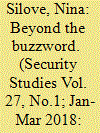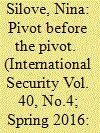|
|
|
Sort Order |
|
|
|
Items / Page
|
|
|
|
|
|
|
| Srl | Item |
| 1 |
ID:
158408


|
|
|
|
|
| Summary/Abstract |
The questions of how to define grand strategy and whether it “exists” continue to vex the study of grand strategy, despite the ever-increasing popularity of the term. Scholars broadly agree that grand strategy refers to something that has the characteristics of being long-term in scope, related to the state's highest priorities, and concerned with all spheres of statecraft (military, diplomatic, and economic). The precise entity or phenomenon that manifests these characteristics is less clear, indicating deficiencies in the methods used by scholars—usually implicitly—to define and operationalize concepts. This article traces the intellectual history and contemporary usage of the concept of grand strategy to identify the phenomenon or object to which the concept refers. This analysis demonstrates that there is no single concept of grand strategy. Instead, there are three, which are labelled “grand plans,” “grand principles,” and “grand behavior,” respectively. Each concept provides a distinct, valuable framework for research and policy prescription.
|
|
|
|
|
|
|
|
|
|
|
|
|
|
|
|
| 2 |
ID:
145229


|
|
|
|
|
| Summary/Abstract |
American critics of the Barack Obama administration's 2011 “pivot to Asia” policy claim that, despite the lofty rhetoric, the United States has pursued an anemic strategy in Asia. Chinese critics of the pivot to Asia assert that it is a bellicose strategy aimed at containing China's rise. These two conflicting criticisms are addressed in a detailed historical narrative that traces the development and implementation of U.S. strategy, based on declassified documents, some of which have never before been made public, and extensive in-depth interviews with senior policymakers. Neither American nor Chinese critics of the pivot to Asia are correct. If this policy is properly dated and measured, the United States undertook a substantive military, diplomatic, and later economic reorientation toward Asia. That reorientation started in the mid-2000s, well before the pivot announcement. The aim of the reorientation was not to contain China's rise. Rather, the United States sought to manage China's growth through a blend of internal and external balancing combined with expanded engagement with China. These means were intended to work symbiotically to expand the combined power of the United States and its allies and partners in Asia, and to dissuade China from bidding for hegemony. The ultimate effect of the reorientation strategy—if successful—would be to preserve the existing power balance in the region, in which the United States has held the superior position.
|
|
|
|
|
|
|
|
|
|
|
|
|
|
|
|
|
|
|
|
|